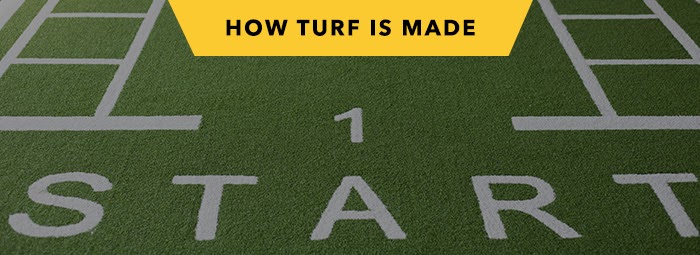
Originally posted on April 27, 2020
Artificial grass grabs your attention, right? You’ve probably seen it around and know a bit about taking care of it. But have you ever scratched your head and thought, “What’s this stuff actually made from?” or “How do they make it?”
We’ve got the answers to those questions and more. Let’s explore some artificial turf!
Terms to Know
Before we go into detail about how turf is made, we should cover some terminology. Here are some definitions that are important to understand in the world of artificial turf:
- Thatch is the individual tufts of fibers, or yarn, that create the lush and plush “grassy” texture of artificial turf. If you think of a thatched roof, thatching is done with natural fibers like straw, leaves, and grasses, woven together to create a covering for insulation. Artificial turf thatch is very similar. Thatch not only provides the more realistic texture of turf, but also color variation for a more natural appearance.
- Pile refers to the length and height of individual yarn, or blades of grass. Longer pile is longer grass and a shorter pile is shorter grass — simple and easy to remember!
- Face weight is the measurement of density of the grass, as determined by the weight of the yarn per square yard. A turf with 90 face weight, or 90 ounces, has a denser and lusher feel and appearance than a turf with a face weight of 60.
- Gauge refers to the distance between rows of stitches. A wider gauge means there will be more space between the tufts of fibers. Gauge can affect the appearance, texture, and functionality of the turf, and varies between varieties of turf based on how it is used.
- Backing is the layer of material that the individual yarns are tufted through. The backing holds the thatch and the pile together, which is also the layer that infill sits on to hold it in place.
- Infill is a granulated product like sand or acrylic beads that is spread over turf. The infill sits between the blades of glass on the base to weigh it down and help the individual blades stand upright. A good infill also helps with drainage, cushion, and traction. There are a variety of infills based on needs, such as pet infill, which is nontoxic to pets and also has antimicrobial and anti-odor properties to help keep it clean and sanitary. Microban is a common choice for pet turf infill. Some turfs, such as that used for indoor soccer fields, don’t require infill, using adhesive to hold it in place instead.
- Base is the surface turf sits on. Turf is adaptable to many different types of surfaces, from concrete to gravel. The base is evaluated for drainage level, padding, and more.
What is artificial turf made of?
The blades of artificial grass, or yarn, are made with nylon, polypropylene or polyethylene pellets that have been melted and mixed with other chemicals and additives to change the color and add preservative properties. The backing of artificial turf, which holds the blades of grass, can be felt, latex, polyester, or polyethylene.
How is artificial turf made?
Artificial turf was invented in the 1960s by the carpet industry, and shares a very similar manufacturing process with carpet. Anyone who is familiar with the manufacturing process of fibers used for textiles, like yarn, may recognize some aspects of the process. You can watch turf being made here:
Stage 1
The manufacturing process begins with melting nylon, polypropylene or polyethylene pellets, and mixing them with other chemicals and additives to add color and preservative properties.
Stage 2
The mixture of melted pellets are then extruded and shaped into individual strands, which are then pulled and stretched to strengthen them. From there, the strands are rolled into spools. Then, those spools are used to spin the strands together into a yarn.
Stage 3
The yarns are then taken to a tufting machine which sews the fibers onto a mesh material. Yarns are sewn to create even rows of loops, which are then cut to create the appearance of blades of grass.
Stage 4
The mesh tufted with yarn is adhered to the backing material. Lastly, the turf backing is punctured by pins to make sure that it is permeable for water drainage. Stress tests are performed on the turf for quality control. Once the turf has been approved, it is ready to install.
Then & Now
Technological advances in the 60s are what made artificial turf possible, and further advances make turf even better. The actual manufacturing process hasn’t changed much, (other than becoming, faster, more efficient, and more affordable) but the design of turf itself has made some advancements.
Modern artificial turfs use technology to make the blades of turf closer resemble natural grass; Luster Guard is an additive that diffuses UV rays, giving the grass a low luster appearance that resembles natural grass, and helps prevent the color from fading. Shaped blades, such as S Blade and Tidal Wave also recreate the appearance and texture of natural grass.
Turf Factory Direct offers the best deals on the latest in turf technology, including S Blade and Tidal Wave designs with Luster Guard. In addition to making turf more attractive and durable, technological advances have also allowed for the creation of more varieties of turf to fit the needs of users.
Where to go From Here
If you’d like to learn more, get in touch with one of our customer service representatives, or start browsing our product lines today! Our blog also provides resources for the selection and installment of turf. Our turf experts are working around the clock to make sure that you’re receiving the best and most affordable turf for any application.








